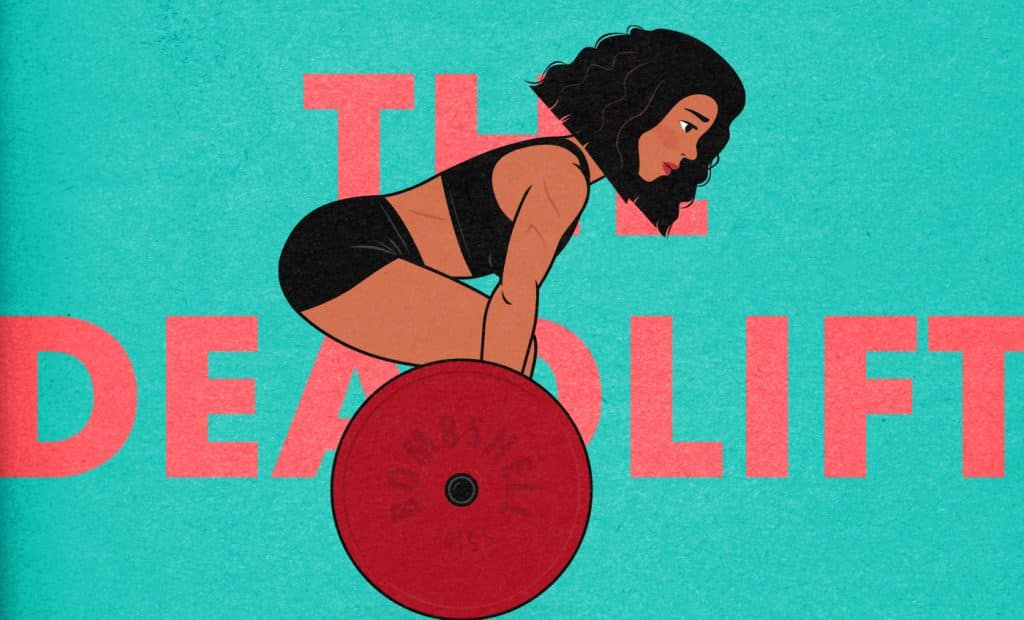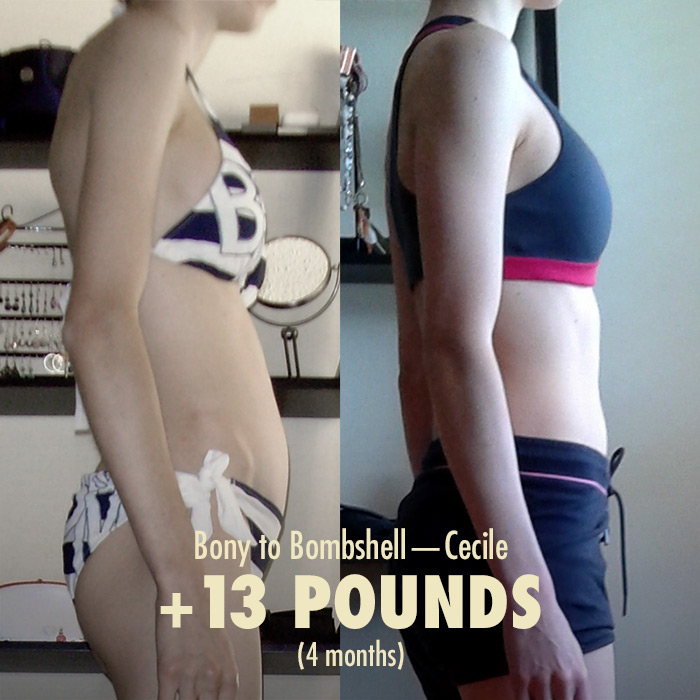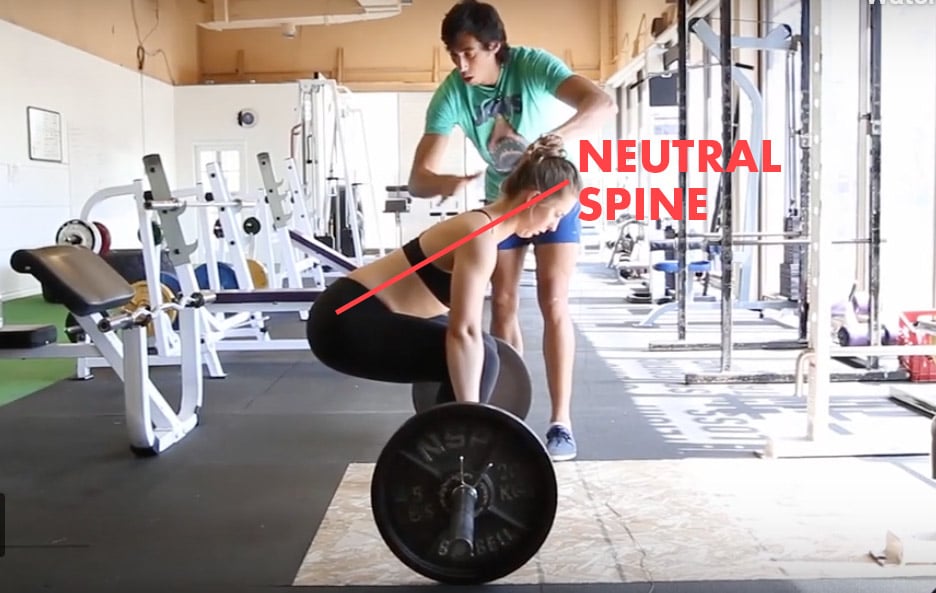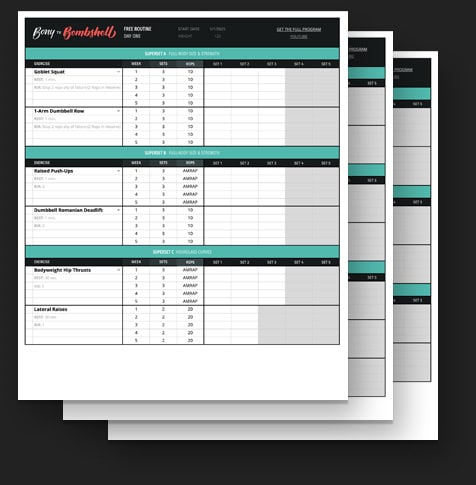
Deadlifts For Women: Overview, How-to, & Workout
The deadlift exercise is a core movement we’ll use all throughout our lives. Sink back into the hips to bend over and pick up a “dead” weight from the floor. It’s an amazing exercise for women looking for postural improvements, gaining muscle mass, and developing athleticism. Let’s take a closer look.
Deadlifts: The Overview
Benefits
All deadlift variations, which are primarily a hip-hinge movement, carry similar benefits.
- Improves posture. If you have a slumpy posture, deadlifts can help. When you hip-hinge and bend over, the weights will work your spinal erectors. These muscles go up along your spine to stabilize them. Studies have shown that by doing exercises that work these muscles, you can help fight against things like kyphosis and anterior pelvic tilt.
- Improves grip strength. When you’re holding the weight, you will need to fight to keep the weight from slipping away. Most women wouldn’t mind a little more grip strength for holding heavy bags (and opening that stuck lid on a pickle jar.)
- Increases muscle mass in all the right areas. When you deadlift, because it’s a compound exercise (works many joints at once), it will add muscle all throughout the body. Not only does this provide a natural, balanced look, but it’s more athletic.
- Boosting metabolism for fat loss. On this website, while we teach women how to gain weight through muscle, we do help skinny-fat women trim fat. Deadlifts are a great exercise to include when focusing on fat loss to remind the body to hold onto muscle while lowering energy intake.
- It makes you more athletic, which adds a finishing sheen to your physique. While deadlifts are solid for building muscle, they’re often discounted for being too fatiguing. But you’re not just doing this exercise to gain muscle or shed fat (although it can help with both). This exercise will test your entire body, and that will help your whole body learn to work athletically as one unit. Your body will become physically capable and graceful. When you’re athletic, little muscles pop out that you wouldn’t have normally noticed. Maybe the sides of your glutes are rounded out. Maybe your forearms look a bit more badass. Maybe you’re standing a little less slouchy and look more lively. Maybe your shoulders cap a bit to give you a great hourglass shape. Being athletic translates into real life, making it easier—hauling groceries, picking up kids, and lifting heavy travel bags.

Muscles Worked
The deadlift is a full-body exercise. You might notice that even your fingers get a little sore from these ones. However, it is more lower-body-focused.
- Hamstrings (the back of your thighs). Your hamstrings might feel like a stretched rubber band firing at the bottom of the movement.
- Glutes. The glutes get placed in a good stretch as you sink back into your hips and will help you thrust the weight as you stand back up tall.
- Forearms. Your grip strength will improve a lot with these ones.
- Postural, core, hips, and all of the main stabilizer muscles. Every little muscle that contributes to you standing up tall, this lift hits them. Spinal erectors, obliques, abs, upper back, lower back, etc.
Types Of Deadlifts
The deadlift, at its most fundamental definition, is sinking back into your hips and picking a “dead” weight off of the ground. This differs from a squat, which is more knee-dominant (and you stay upright), and the weight isn’t starting from the floor.
So the deadlift is a hip-hinging movement. So there are all sorts of variations of it, depending on what equipment you have access to or if you want to keep things fresh. Here are some deadlift variations:
- Conventional barbell deadlift. This is your classic deadlift that most people would reference. You use a normal hip width stance (as if you were going to jump or a tiny bit wider.) You’ll want to use big enough plates so the barbell is raised high enough off of the ground to grip. So unless you have bumper plates, this usually means a conventional barbell deadlift will start at 135 pounds (45-pound Olympic bar + 45 pounds plates x 2)
- Sumo barbell deadlift. This is a barbell lift, like the original lift, but your stance is wider than your hands/grip, turning it into a “sumo” stance. This variation keeps your body more upright and can be easier on the lower back, with less work for the glutes/hams but harder on the quads.
- Dumbbell deadlift. If you want to keep set-up simple or you’re training at home without a barbell, you can still do the hip hinge movement. In this case, most people normally just do the dumbbell RDL, but you can totally go all the way down and touch the weight to the floor.
- Dumbbell Sumo deadlift. This is a good beginner variation because there’s no set-up (just a single dumbbell), it’s light, and you’re a bit more upright. The technique is easy and simple to learn.
- Barbell Romanian Deadlift. This variation starts with the weight up off the floor. It is 100% all hip-hinging, and there is no knee movement which is required to get the weight down onto the floor like the conventional deadlift. For this reason, it’s a lighter exercise that tends to work the hamstrings, glutes, and forearms well.
- Dumbbell Romanian Deadlift. This, like the barbell RDL, is a great hamstring, glute, and forearm variation but with little to no set-up. Just grab two dumbbells and start hinging.
- Hex-barbell Deadlift. This specialty barbell isn’t at every gym, but it’s common enough to mention. This version allows you to stay more upright, as you don’t need to wait until the barbell clears your knee before you knee-bend, like the conventional version. That makes it a go-to for those who want to deadlift but feel like the conventional makes their back a bit touchy.
- Raised Deadlifts (and rack pulls.) Raised deadlifts are a beginner variation to help someone work their way down to the floor. You can also use this variation if you can’t yet lift 135 pounds and need to use the shorter-weight plates. Rack pulls are done in a squat cage on safety pins. Like a raised deadlift, you don’t need to get down as low. This lift is normally used to shorten the range of motion, so you can lift heavier.
- Speed deadlifts. This is a traditional stance but with a light weight so that you can focus on explosive movement, do more reps and use less rest time. It’s a great accessory exercise to add in if you like the deadlift and want to do more of them or more often without hampering your ability to recover.
Conventional Barbell Deadlift Video Demonstration
Here’s Marco coaching Marielle on how to do the regular barbell deadlift:
Conventional Barbell Deadlift Proper Form Breakdown
- Grab an Olympic bar and some Olympic plates. You’ll need at least two 45-pound weight plates to get the optimal height off the floor, so a 135 starting weight.
- Pick up one side of the empty barbell, and slide the Olympic plate onto it. Add a barbell collar to make sure the weights don’t slide around, and do the other side the same way.
- Step up close to the barbell and get the stance right. Your stance should be as if you were going to jump—that’s your power position. The balls of your feet will be under the barbell.
- Sink back into your hips, and let your arms drape down until your hands can grip the barbell in a comfortable position.
- A double overhand grip is a good default. That means palms down (away from you.)
- This is your starting position for each rep.
- Take a deep breath, and pull a little on the barbell to take the slack out.
- Explosively stand up, pushing through your heels, as you breathe out.
- From the top position, take a deep breath, and under control, begin to sit back into your hips and lower the weight down to the floor.
- Don’t bounce the weight between reps. There are two schools of thought. You can tap the weight lightly or let it fully rest on the ground for half a second, full stop, keeping your muscular tension high, before doing the next rep. There’s no wrong answer. Just stay consistent.
- When you’re done with all the reps, go take a seat somewhere, even on the floor, to help your body recuperate.
Mastering The Deadlift Technique
There are a lot of moving parts to the deadlift technique, but with effort and patience, you can master it.
Neutral Spine
Deadlifts are famous for curing low back pain. But other people will say it causes their back to flare up. What gives? It’s all about your form. If your low back is doing all of the lifting, you’re going to get back pain. You must lighten the weight and practice a neutral spine.
If your spine isn’t in a neutral position, the weight will be supported by the wrong muscles (like your lower back), which will get overused and sag. This will lead to back pain.
A neutral spine is when your upper back isn’t rounded, your lower back isn’t sagging, and you aren’t contorting your neck up to stay looking forward. Instead, your back is in a completely straight line, which is what we call a neutral spine.

Here’s a good video from Marco talking about what a neutral spine is and some drills you can do to improve it if you’re having a hard time with the hip hinge movement.
Grip Style And Hand Placement
We like the double-over-hand grip as the default. It is harder on the forearms, but it develops better grip strength and athleticism. It also prevents you from lifting heavier than you can actually lift.
Some people will use a mixed grip, which is where one palm is down, and the other is up, which prevents the barbell from slipping. But you have to make sure you switch hands each set, and it puts one arm in a less sturdy position.
Other people will use straps or hook grips, but that’s more in the powerlifting or powerbuilding community, and most women (and men, for that matter) won’t need to worry about that.
Breathing And Bracing
Breathing and abdominal bracing are incredibly important while deadlifting heavier weights. Perhaps you’ve seen the videos of people fainting after deadlifting a heavy weight. That’s partially because the weight was too heavy, the rep was too slow, and they held their breath through the entire time, making them light-headed.
It’s key to breathe at the right times and to select the right weight.
- Take a breath in to brace.
- Lift explosively, and keep most of the air in.
- At the top portion of the lift, you can exhale.
- When you’re standing tall, you can take a breath in and let the air out slowly as you lower the weight.
Not only will that keep you breathing through the whole lift, it will help your body brace against the weight.
When you take a deep breath in, you increase your “intra-abdominal pressure.” This pressure inside your body helps with spine stability and “trunk rigidity.” (2013). So this can help minimize any back pain because proper bracing will help provide an imaginary weight belt around your back, keeping it tight and in place. Meanwhile, the exercise will work your spinal erectors, helping you develop an even stronger back.
Side note: this same intra-abdominal pressure build-up is the same reason that some women (mostly mothers) can experience peeing when lifting weights. It’s called stress incontinence (2020) and can happen with a weaker pelvic floor and too much intra-abdominal pressure. If this is a concern, you can always avoid heavy lifts like this, use a lighter weight, make sure to pee directly before lifting, keep your lifting sessions shorter, and/or work on restoring your pelvic floor (which is related to collagen degradation and stiffening.)
Common Mistakes With The Deadlift
- Choosing too heavy of a weight. If the weight is too heavy, your lower back will pick up the slack, and your form will crumble. When your pelvis tucks under like that, it can also cause tailbone pain.
- Choosing too light of a weight. You’ll need at least enough weight to get the barbell to the right height. But you might find that even 135 pounds is too light. At that point, your form can be wonky with a light weight since your body doesn’t need to be efficient.
- Bending the knees too early so the barbell slides down your thighs. This happens when you’re not sitting back far enough and you’re too upright. You need to bend over and push those hips back. This might mean lightening the weight a bit.
- Hips shooting up too high. Make sure to push through the ground first and use your legs instead of your lower back until the barbell clears your knees.
- Not breathing! Too many people hold their breath and bang out reps and wonder why they feel so lightheaded. At the very least, you should be doing a full breath in between reps, depending on how you like to brace.
Here’s a video of Marco going over common mistakes with the deadlift:
Using Deadlifts In A Female Workout
Use A Lower Rep Range
In research, to optimize for muscle growth and muscle size, you want to choose a weight that you can do 4–40 repetitions with. The sweet spot for deadlifts, though, is on the lower rep range of around 5-7 reps. The reason why is because the deadlift exercise is one of the most fatiguing exercises in history. It is best to do it for a handful of reps, stimulate the whole body, then move on to other less-fatiguing exercises.
If you find yourself not able to do 5 reps, use a lighter weight. If you can do more than 9 repetitions, use a heavier weight. That will guarantee that the workout is helping you gain both muscle size and muscle strength and not making endurance adaptations.
Challenge Yourself But Stop Shy Of Failure
Ideally, you’ll stop your deadlifts when you’re just about to fail, but you could still do a couple of reps more. But if you’re a beginner, it’s hard to know exactly how hard you’re pushing yourself. Normally, we recommend exploring what failure feels like, but because deadlifts are heavy and they involve your spine, it’s not the best idea for beginners to do this. Err on the side of lifting too light, and if it’s too light, count it as a warm-up. Keep working up, and you’ll know when the weight is right for your goal reps.
Start With Two Sets, and Add More When Needed
Start with just a couple of sets, then over time, add more sets as you get stronger. We recommend doing two sets in the first week. Practice your form, find the right weights, and take your time learning the hip-hinging motion.
Next week, if your fingers, low back, and hamstrings aren’t too sore at the start of each workout, try adding a set to each exercise. If that goes well and you feel ready for more, add another set next week. You can do around 3–6 sets per exercise. Most women will do best with 3–4 sets. If you ever start to feel worn down, or if you’re coming back after a long break, start the cycle over again, going back to just two sets and rebuilding from there.
Rest 2-3 Minutes Between Sets
How long you rest between sets of deadlifts isn’t that important. Whether you rest for 2 minutes or 10 minutes, you’ll still stimulate a similar amount of growth. The important thing is that you rest long enough to catch your breath, ensuring that your cardiovascular system doesn’t limit the performance of your muscles.
We want to challenge your grip, hamstrings, and glute muscles—not just your heart (though your heart will get a good workout, too!)
The main reason to rest for just a couple of minutes is to keep your workouts shorter. You don’t want to spend all day in the gym. But if you need more rest or get interrupted partway through your workout, no problem. Just pick up where you left off.
If you want to blast through your workout even faster, you can do the lifts in a circuit/superset. Do a set of deadlifts, rest a minute, then do a set of push-ups, rest a minute, then do your second set of deadlifts, and then do your second set of push-ups. That way, you’re still giving different muscle groups plenty of time to recover between sets, but you’re doing another exercise during the rest period.
Free Routine For Female Beginners: Full Body Workout That Includes The Barbell Deadlift
If you don’t have a workout, you might be interested in our full Bony to Bombshell program. A sample beginner’s workout for women that includes deadlifts could look like this:
- Barbell Deadlift: 2 sets of 10 repetitions.
- Raised Push-Ups: 2 sets of as many reps as you can.
- 1-Arm Dumbbell Row: 2 sets of 10 repetitions.
- Dumbbell Goblet Squats: 2 sets of 10 repetitions.
- Lateral Raises: 2 sets of 10 repetitions.
- Bonus Glute Work: 2 sets of glute bridges or hip thrusts
GET THE GOOGLE SPREADSHEET OF THE
FREE female BEGINNER’S Deadlift & FULL-BODY WORKOUT

Get the workout as a Google spreadsheet. You’ll be able to pick from exercise alternatives, and fill out the sheet.
Plus, we’ll make sure you’re on the Bony to Bombshell newsletter, and send you all of our best women's muscle-building content.
Q&A About The Deadlift
Q: How heavy should I deadlift?
A: In general, you want the barbell to be the right height, so you need the tallest Olympic plates. Those are usually 45 pounds, so at minimum most women will need to be deadlifting 135 pounds. The barbell brings stability, so you might be surprised that you’re stronger than you think. But if that seems too heavy, start off with the dumbbell Romanian deadlift to build up strength.
Q: How often should I do deadlifts?
A: That depends on your goals, but in general, because it’s such a fatiguing lift, doing it once a week is more than enough.
Some women might really want to master the lift, so they can include other hip-hinging exercises throughout the week (dumbbell RDLs, etc.), or if they really want to, they could program some lighter speed deadlifts a couple of days later.
But if your goal is just to get general hamstring and glute growth, you’ll want to pair that exercise with other lower-body exercises for balanced growth. Think of things like dumbbell goblet squats, dumbbell RDLs, and glute bridges.
Q: Can I do the deadlift at home?
A: Of course. Some women have already bought a barbell, a barbell pad, and Olympic plates for home use so they can master the glute bridge and hip thrusting with privacy. They could totally do the barbell deadlift at home, too. No squat cage is needed.
But if all you have is a kettlebell or dumbbell, you can use that too to do a deadlift motion. Here’s the dumbbell sumo deadlift. (It’s considered sumo stance because your hands are in between your knees.)
Deadlift Variations With Video Demonstrations
Rack Pulls Or Raised Deadlifts
There’s a bit more set-up with the rack pulls or raised deadlifts, but they can be worth the effort. They’re good for female beginners who don’t have the mobility yet, but want to practice the deadlift form with a smaller range of motion. And they’re also good for advanced lifters who want to increase the weight and just do the range of motion of the deadlift where it counts (with no knee bend.)
Sumo Barbell Deadlift
With the Sumo barbell deadlift, your stance is wider, your toes are pointed outwards to line up your knees, and your hands grip the barbell between the knees. This option is more upright, so it’s a little easier on the lower back. it can be a helpful variation for someone with a long torso. Because it’s more upright, there’s more knee-bend, and so it’s more of a quad lift (front of thigh) rather than the hamstrings and glutes.
What Next?
By incorporating deadlifts into your lifting routine, your grip, hamstrings, glutes, and general posture will be thanking you. If you liked this article, you’d love our muscle-building newsletter. We’ll keep you up to date on all the latest muscle-building information for women. Or, if you want us to walk you through the process of building muscle, including teaching you the lifts, giving you a full workout program, a complete diet guide, a recipe book, and online coaching, check out our Bony to Bombshell Program.



FREE women's Muscle Growth MINI-COURSE
Get our 5-part female bulking mini-course that covers everything you need to know about:
Here are some related articles